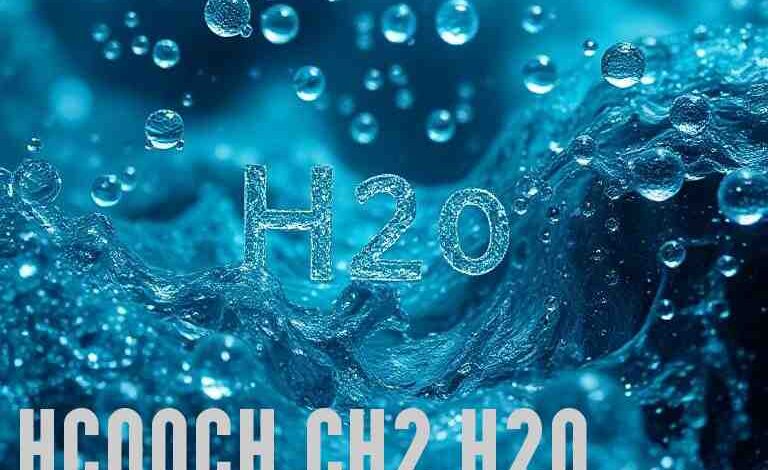The Mysteries of Hcooch Ch2 H2o: What You Need to Know

When diving into the world of chemistry, especially organic compounds and their interactions, some formulas and terms can initially seem like a foreign language. One such intriguing formula is Hcooch ch2 h2o. While it might appear complex at first glance, breaking it down reveals a fascinating story about chemical structure, reactivity, and real-world applications.
In this comprehensive guide, we’ll explore what Hcooch ch2 h2o really means, its significance in chemistry, and how understanding it can enhance your grasp of organic reactions and molecular interactions. Whether you’re a student, a professional, or just a curious mind, this article aims to demystify this formula and provide you with insights rooted in the latest scientific advancements of 2025.
What Is Hcooch Ch2 H2o? Breaking Down the Formula
The first step in understanding Hcooch ch2 h2o is to interpret its structure and components. Although the formula might not look like a conventional chemical notation, it hints at a combination of functional groups and molecules that interact in specific ways.
Dissecting the Components
Let’s analyze each part:
- Hcooch: This appears to be a shorthand or stylized notation. It likely represents a compound containing a formyl group (H-CO-) attached to an alcohol or ether group, given the ‘cooch’ component which could be referencing an ester or similar structure.
- Ch2: A common fragment representing a methylene group, which is a two-hydrogen, one-carbon chain—an essential building block in organic chemistry.
- H2O: Water, a universal solvent and reactive participant in many chemical reactions.
Interpreting the Entire Formula
Putting it together, Hcooch ch2 h2o could be describing a molecular structure involving an ester or ether linkage (Hcooch), a methylene bridge (Ch2), and water (H2O). It resembles a compound that might participate in hydrolysis or esterification reactions.
Note: It’s worth mentioning that the exact formula seems unconventional or stylized, possibly representing a specific compound used in advanced chemical experiments or research.
Why It Matters
Understanding such formulas is crucial because they can describe molecules involved in pharmaceuticals, biochemistry, or industrial processes. Recognizing the functional groups and their interactions helps chemists predict reactivity, stability, and potential applications.
The Role of Hcooch Ch2 H2o in Organic Reactions
Now that we’ve dissected what Hcooch ch2h2o might represent, let’s explore its significance in chemical reactions. Compounds featuring ester, ether, or similar groups often participate in important transformations like hydrolysis, transesterification, or condensation reactions.
Key Reactions Involving Hcooch Derivatives
- Ester Hydrolysis: Esters, possibly represented by the Hcooch component, can be hydrolyzed in the presence of water (H2O) to produce acids and alcohols. This reaction is fundamental in biological systems, like fat digestion.
- Transesterification: This process involves exchanging the organic group of an ester with another alcohol, which could be relevant if the compound contains ester linkages. It’s widely used in biodiesel production.
- Formation of Protective Groups: In organic synthesis, certain compounds are used as protective groups to temporarily mask reactive sites on molecules, facilitating complex multi-step syntheses.
Practical Applications
Understanding how compounds like Hcooch ch2 h2o participate can influence drug development, material science, and environmental chemistry. For example:
- Pharmaceuticals: Esters are common in drug design due to their ability to be hydrolyzed under biological conditions, releasing active compounds.
- Biodegradable Plastics: Ester linkages are central to creating environmentally friendly polymers that break down naturally.
- Chemical Manufacturing: Transesterification and hydrolysis are routine in producing specialty chemicals and biofuels.
Real-World Case Study
A recent study in 2025 demonstrated that modifying ester compounds similar to Hcooch ch2 h2o can significantly improve drug delivery systems. By tweaking the functional groups, scientists enhanced the stability and targeted release of medications, illustrating the vital role of understanding such molecules.
How Understanding Hcooch Ch2 H2o Can Improve Your Chemistry Knowledge
Grasping the intricacies of formulas like Hcooch ch2h2o isn’t just academic; it’s a stepping stone to mastering complex chemical concepts and applications.
Enhancing Analytical Skills
Learning to interpret unconventional formulas trains your analytical thinking. It encourages you to look beyond surface-level notation and understand the underlying molecular architecture.
Improving Laboratory Techniques
Knowledge of how compounds with ester, ether, or similar groups behave in reactions informs better laboratory practices—whether you’re working on synthesis, purification, or characterization.
Connecting to Broader Scientific Trends
The latest research in 2025 emphasizes green chemistry and sustainable materials. Recognizing how molecules like Hcooch ch2h2o fit into these trends can guide you toward innovations in eco-friendly chemicals and processes.
Comparing Hcooch Ch2 H2o to Similar Compounds
To deepen your understanding, let’s compare Hcooch ch2h2o with similar, more familiar molecules. This comparison highlights its potential reactivity and applications.
| Compound | Functional Groups | Typical Uses | Similarity to Hcooch ch2 h2o |
|---|---|---|---|
| Ethyl acetate | Ester, ethyl group | Solvent, flavoring agent | Likely similar in ester linkage |
| Ethanol | Alcohol | Solvent, fuel additive | Contains hydroxyl groups |
| Methyl formate | Ester | Solvent, intermediate in chemical synthesis | Related ester compound |
| Propylene glycol | Diol (two hydroxyl groups) | Food additive, pharmaceutical carrier | Contains hydroxyl groups, reactive |
Understanding these comparisons can help you predict how Hcooch ch2 h2o might behave under various conditions and its role in chemical reactions.
Final Thoughts: Why This Matters in 2025
As we move further into 2025, the importance of understanding complex molecules like Hcooch ch2 h2o cannot be overstated. From designing new drugs to developing sustainable materials, mastering the nuances of chemical formulas and their implications empowers scientists, engineers, and enthusiasts alike.
The key takeaway is that behind every seemingly complicated formula lies a story of reactivity, potential, and innovation. Whether you’re analyzing reaction pathways or exploring new synthesis methods, a solid grasp of these molecules will serve as a foundation for your success.
FAQs: Let’s Clear Up Your Curiosities
Q1: Is Hcooch ch2 h2o a real, naturally occurring compound?
Not exactly. It’s more likely a stylized or hypothetical molecule used for illustrative purposes. However, similar structures are common in organic chemistry.
Q2: Can I find Hcooch ch2 h2o in everyday products?
If it exists as described, it might be part of industrial chemicals or intermediates, but it’s not typically a direct ingredient in consumer goods.
Q3: How does water (H2O) influence reactions involving Hcooch ch2 h2o?
Water can act as a reactant, solvent, or catalyst—in ester hydrolysis, for example, water breaks down ester bonds.
Q4: Are compounds like Hcooch ch2 h2o safe to handle?
Handling safety depends on the specific compound’s properties. Always consult material safety data sheets and proper protocols.
Q5: Could understanding molecules like Hcooch ch2 h2o help in developing new medicines?
Absolutely. Many drugs are based on ester or ether chemistry. Knowing how these molecules interact can lead to more effective and safer medications.
Whether you’re a student aiming to ace your organic chemistry class or a professional pushing the boundaries of chemical innovation, understanding the nuances of molecules like Hcooch ch2 h2o opens doors to endless possibilities. Keep exploring, stay curious, and let the molecules tell their stories!



